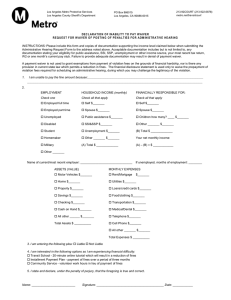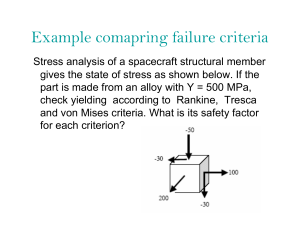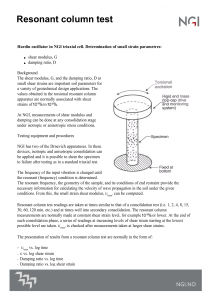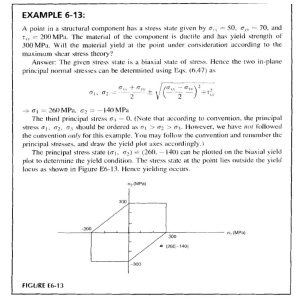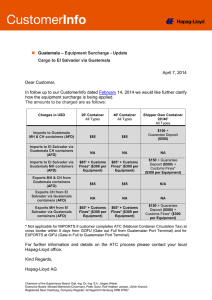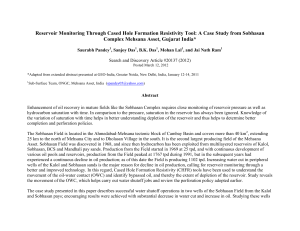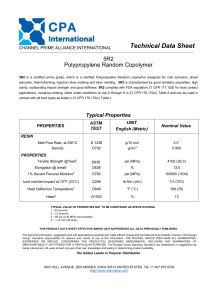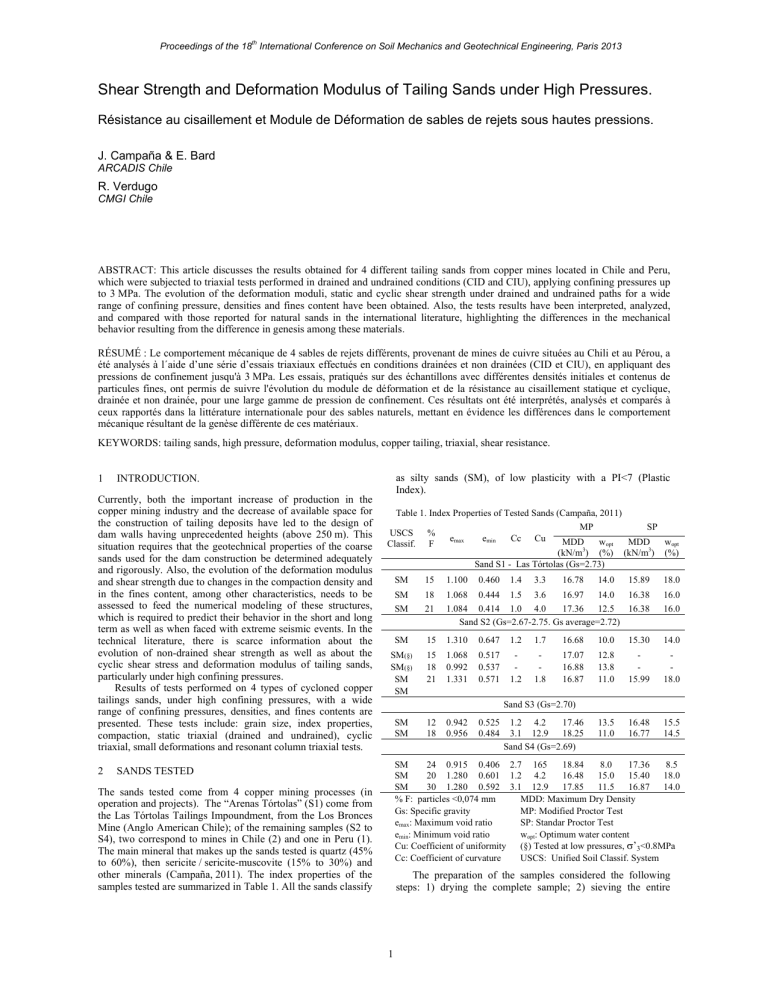
th Proceedings of the 18 International Conference on Soil Mechanics and Geotechnical Engineering, Paris 2013 Shear Strength and Deformation Modulus of Tailing Sands under High Pressures. Résistance au cisaillement et Module de Déformation de sables de rejets sous hautes pressions. J. Campaña & E. Bard ARCADIS Chile R. Verdugo CMGI Chile ABSTRACT: This article discusses the results obtained for 4 different tailing sands from copper mines located in Chile and Peru, which were subjected to triaxial tests performed in drained and undrained conditions (CID and CIU), applying confining pressures up to 3 MPa. The evolution of the deformation moduli, static and cyclic shear strength under drained and undrained paths for a wide range of confining pressure, densities and fines content have been obtained. Also, the tests results have been interpreted, analyzed, and compared with those reported for natural sands in the international literature, highlighting the differences in the mechanical behavior resulting from the difference in genesis among these materials. RÉSUMÉ : Le comportement mécanique de 4 sables de rejets différents, provenant de mines de cuivre situées au Chili et au Pérou, a été analysés à l´aide d’une série d’essais triaxiaux effectués en conditions drainées et non drainées (CID et CIU), en appliquant des pressions de confinement jusqu'à 3 MPa. Les essais, pratiqués sur des échantillons avec différentes densités initiales et contenus de particules fines, ont permis de suivre l'évolution du module de déformation et de la résistance au cisaillement statique et cyclique, drainée et non drainée, pour une large gamme de pression de confinement. Ces résultats ont été interprétés, analysés et comparés à ceux rapportés dans la littérature internationale pour des sables naturels, mettant en évidence les différences dans le comportement mécanique résultant de la genèse différente de ces matériaux. KEYWORDS: tailing sands, high pressure, deformation modulus, copper tailing, triaxial, shear resistance. 1 Currently, both the important increase of production in the copper mining industry and the decrease of available space for the construction of tailing deposits have led to the design of dam walls having unprecedented heights (above 250 m). This situation requires that the geotechnical properties of the coarse sands used for the dam construction be determined adequately and rigorously. Also, the evolution of the deformation modulus and shear strength due to changes in the compaction density and in the fines content, among other characteristics, needs to be assessed to feed the numerical modeling of these structures, which is required to predict their behavior in the short and long term as well as when faced with extreme seismic events. In the technical literature, there is scarce information about the evolution of non-drained shear strength as well as about the cyclic shear stress and deformation modulus of tailing sands, particularly under high confining pressures. Results of tests performed on 4 types of cycloned copper tailings sands, under high confining pressures, with a wide range of confining pressures, densities, and fines contents are presented. These tests include: grain size, index properties, compaction, static triaxial (drained and undrained), cyclic triaxial, small deformations and resonant column triaxial tests. 2 as silty sands (SM), of low plasticity with a PI<7 (Plastic Index). INTRODUCTION. Table 1. Index Properties of Tested Sands (Campaña, 2011) MP USCS Classif. % F emax SM 15 1.100 SM SM 18 21 emin Cc Cu 0.460 1.4 3.3 SP MDD (kN/m3) wopt (%) 15.89 18.0 1.068 0.444 1.5 3.6 16.97 14.0 16.38 1.084 0.414 1.0 4.0 17.36 12.5 16.38 Sand S2 (Gs=2.67-2.75. Gs average=2.72) 16.0 16.0 MDD wopt (kN/m3) (%) Sand S1 - Las Tórtolas (Gs=2.73) 16.78 14.0 SM 15 1.310 0.647 1.2 1.7 16.68 10.0 15.30 14.0 SM(§) SM(§) SM SM 15 18 21 1.068 0.992 1.331 0.517 0.537 0.571 1.2 1.8 17.07 16.88 16.87 12.8 13.8 11.0 15.99 18.0 SM SM 12 18 0.942 0.956 0.525 0.484 13.5 11.0 16.48 16.77 15.5 14.5 Sand S3 (Gs=2.70) 1.2 4.2 17.46 3.1 12.9 18.25 Sand S4 (Gs=2.69) SM 24 0.915 0.406 2.7 165 18.84 8.0 17.36 8.5 SM 20 1.280 0.601 1.2 4.2 16.48 15.0 15.40 18.0 SM 30 1.280 0.592 3.1 12.9 17.85 11.5 16.87 14.0 % F: particles <0,074 mm MDD: Maximum Dry Density Gs: Specific gravity MP: Modified Proctor Test emax: Maximum void ratio SP: Standar Proctor Test emin: Minimum void ratio wopt: Optimum water content Cu: Coefficient of uniformity (§) Tested at low pressures, ’3<0.8MPa Cc: Coefficient of curvature USCS: Unified Soil Classif. System SANDS TESTED The sands tested come from 4 copper mining processes (in operation and projects). The “Arenas Tórtolas” (S1) come from the Las Tórtolas Tailings Impoundment, from the Los Bronces Mine (Anglo American Chile); of the remaining samples (S2 to S4), two correspond to mines in Chile (2) and one in Peru (1). The main mineral that makes up the sands tested is quartz (45% to 60%), then sericite / sericite-muscovite (15% to 30%) and other minerals (Campaña, 2011). The index properties of the samples tested are summarized in Table 1. All the sands classify The preparation of the samples considered the following steps: 1) drying the complete sample; 2) sieving the entire 1 th Proceedings of the 18 International Conference on Soil Mechanics and Geotechnical Engineering, Paris 2013 sample; 3) separation of the fines (<0.074 mm) and coarse (>0.074 mm) fractions; 4) preparation of the sample with the fines content predefined by project. The probes were compacted in layers to an initial density representative of the expected in-situ compaction, with the tamping method and with moisture close to optimum (± 2%, according to Standard Proctor). 3 reduction in the strength envelope at high pressures was observed, this behavior is in contrast with the one observed with the Sacramento Sand reported by Lee & Seed (1967). The little quantity of particles crushing that is produced in the tailings sands with the increase of confinement could be explained this unexpected behaviour. This evidence was observed systematically in the grain size tests performed before and after each triaxial test (Campaña et al., 2007). UNDRAINED SHEAR STRENGTH (SU) Figure 1 presents the variation of Su for the different sands as a function of the void ratio (e) and the fines content. It is important to note that the void ratio (e) indicated correspond at the end of consolidation phase. Figure 3. Drained and undrained residual strength curves. a) all the tests, b) detail for ’3<2 MPa. 5 Although the ultimate state (steady state) has not clearly reach in all the tests, by plotting the final results in the graph (elog p’), it can be observed that the results allow to mark off with a reasonable precision the combination of density and confinement pressure that determine that the sands present a contracting or dilating behavior. By comparing the results of this study with the ones reported in the technical literature, the obtained behavior of tailing sands is in accordance with other natural sands of similar mineralogy. These results allow to extrapolate the behavior of tailings sands at higher confining pressures and estimate that these would not present an important decrease in the shear strength. Figure 4 presents all the tests, compared with several results of other sands. Figure 1. Summary of undrained shear strength (Su) variation. Figure 2a presents the variation of Su as a function of the void ratio and Figure 2b presents the average tendency curves for all samples tested. A tendency of Su to decrease as the fines content increases was observed. In addition, and as reference, in these figure 2b results obtained from the Toyoura Sand (fines=0%), tested by Verdugo (1992) in a wide range of relative density (DR=7% to 67%) have been included. The variation of the undrained shear strength with the fines contents estimate a value of zero for Su for average values of e=0.72 (30% and 18-21% of fines), e=0.89 (15% of fines) and e=0.78 (12% of fines). For the different sands tested, these void ratios are associated to relative densities lower than DR<40%. In the Toyoura Sand, Verdugo (1992) recorded zero values of Su for values of DR<15%. Figure 2. Variation of undrained shear strength (Su) with the void ratio (e) and the fines content. Sand samples S1 to S4. (Campaña, 2011) 4 CRITICAL STATE OR PERFECT PLASTICITY Figure 4: Results of triaxial tests in the e-log p’ plane. DRAINED SHEAR STRENGTH 6 The shear strength envelopes in the (q-p’) plane for CID triaxial tests are presented in summary form on Figure 3. Values of residual strength obtained in the CIU tests (Su) were also included. In spite of the wide range of fines content in the four samples tested, the shear strength envelopes obtained are similar. For ’3<1 MPa, it are characterized by internal friction angles () between =32° and =36°; for ’3>1 MPa, the internal friction angles vary between =32° to =34°. No strong DEFORMATION MODULI, Ei (~10-3) To determine the variation of the initial tangent deformation moduli (Ei) at large deformations with the confining pressure, a hyperbolic adjustment (Duncan et. al, 1970) was performed, which was applied both for drained as well as for undrained triaxial tests. The variation of the deformation modulus (Ei) as a function of the confining pressure (’3) and the void ratio (e) may be defined by the following expression: 2 th Proceedings of the 18 International Conference on Soil Mechanics and Geotechnical Engineering, Paris 2013 (1), where A, n are constants that depend on the type of soil (Biarez et al., 1993; Bard,1993). Figures 5a and 5b present the values of Ei obtained through the hyperbolic adjustment of the stress-deformation curves, for the tests performed at different initial densities and different fines contents in drained and undrained conditions (large deformations). 18- 21% F 15% F 30% F Ei '3 = 148 ± 70 e Ei = Módulo Tangente Inicial Ei y '3 (kg/cm2) 1 1.2 1.4 1.6 1.8 2 1/e Figure 5. Normalized Ei variation. All the sands tested: a) drained case, b) undrained (Campaña, 2011). In case of the drained tests, the resulting values of Ei are all practically contained in a narrow band, even when the range of fines content of the sample vary between 15% to 30%. In the case of the undrained tests, a significant dispersion was observed which may be explained by the variation of the pore pressure according the initial value of '3 and density (e). The lower values of Ei correspond to 30% fines and the higher values correspond to fines between 15% and 21%. pressure: 0.3 MPa for Sands S1, S2, and S4 and up to 0.9 MPa for Sand S3. A uniform sinusoidal cyclic load was applied with a frequency of 0.1 Hz for Sand S4 and of 0.05 Hz for Sands S1, S2, and S3. Test results are summarized in several graphs, differentiated by the fines content, confining pressure, and density achieved at the end of the consolidation stage (see Campaña 2011). The results of this tests confirm the tendency reported by Verdugo (1983) for lower confining pressures (’3≤ 0.5 MPa), related to the decrease of the required CSR to produce liquefaction when the non-plastic fines content increases. However, this tendency disappears for confining pressures greater than 0.5 MPa where the CSR practically is a constant. To strengthen this important detection, all the results obtained have been plotted separately on Figure 7a for ’3≤ 0.5 MPa, and on Figure 7b, for ’3≥ 1 MPa. On Figure 6a, a great scattering in the CSR values can be observed for the four sands tested, while a general decreasing trend of CSR values with the increasing number of cycles can be perceived. The results corresponding to Sand S3 contribute significantly to the width of the resulting band. Contrary, on Figure 6b for ’3≥1 MPa, the CSR values obtained range in a very narrow band, without important differences due to initial density or fines content or the cycloned tailings sands. Another relevant aspect to point out from the results of the tests carried out in Sands S2 and S4 for confining pressures greater than 0.5 MPa, are the relatively constant CSR values obtained despite the confining pressure applied (factor K=1), the fines content, the relative density, and even the initial shear stress. Figure 8 presents a comparison of K values obtained in this paper with those obtained by several authors. 0.5 0.5 '35 (kg/cm2), Kc=1 a) 0.4 SHEAR MODULUS GMAX (<10 ) According to Hardin & Drnevich (1972), the variation of the shear modulus at small deformations (Gmax) as a function of the confining pressure (’3) and the void ratio (e) may be expressed as indicated by equation (2), where C0 and n are constants of the material. Plotting the results of the tests (triaxial at small deformations in Sands S1 and S2; resonant column for S3) in one graph to determine the values of C0 and n of equation (2), it was observed that, for the range of pressures and densities tested, the tendency of expected variation for confining pressures '3<1 MPa is reproduced, which does not occur for '3>1 MPa (Figure 6). 18%F, Triaxial (S3) 18% F, C. Resonante (S3) 15%F, Triaxial (S1) 21%F, Triaxial (S1) Rc ( cy / o ') 7 -5 Arena S1 Arena S2 Arena S3 Arena S4 0.3 0.2 '310 (kg/cm2), Kc=1 b) Arena S1 Arena S2 Arena S3 Arena S4 0.4 Rc ( cy / o ') Ei=A.'3n.e-1 0.3 0.2 A=0.32 0.1 0.1 0 Rc=A*N-0.17 A=0.23 0 1 10 100 Número de Ciclos, N (u='0) 1 10 100 Número de Ciclos, N (u='0) Figure 7. Summary all test results: a) for ’3≤ 0.5 MPa, b) for ’3≥ 1MPa, Kc= 1.0 (Campaña, 2011) Hardin & Drnevich (1972) G C Aσ 2 -6 -5 =[10 - 10 ] e=[0.52 - 0.73] '0= [1 - 30 kg/cm2] A 2.97 e 1 e DR>75% 2.5 3 3.5 4 4.5 (2,97-e)2 (1+e) Figure 6. Results of resounding column and triaxial at small deformations tests (Campaña, 2011). 8 CYCLIC SHEAR RESISTANCE (CSR) The cyclic triaxial tests were carried out on reconstituted samples with a nominal diameter of 5 cm (S1, S2 and S4) and 7 cm (S3) and nominal heights of 10 cm and 15 cm, respectively. In all cases, parameter B at the end of the saturation stage was greater than 0.95. Backpressure was applied according to the magnitude of isotropic confining Figure 8. Variation of factor Kwith regard to ’3 9 CONCLUSIONS The interpretation and analysis of the results of the testing program show that, in the domain of confining pressures applied th Proceedings of the 18 International Conference on Soil Mechanics and Geotechnical Engineering, Paris 2013 and the relative densities tested, the shear strength envelopes obtained are very similar to each other. For average confining pressures (p’) above 0.5 MPa, a little reduction in the envelope strength at high pressures, associated to a very reduced crushing of particles is observed. For this reason, the shear strength parameters are not modified significantly even for higher confining pressures. In the same manner, the drained as well as the undrained shear strength envelope is not sensitive to the different fines contents tested, with no significant differences being detected for the range of fines tested, which varied between 12% and 30%. Notwithstanding the above, by considering the average values obtained for the undrained shear strength Su, it is possible to observe a decreasing tendency of the Su as the fines content is increased. With the hyperbolic adjustment of the stress – deformation curves, the evolution of the initial tangent deformation modules (Ei) was determined. In drained tests, even when the range of fines content tested varied between 12% and 30%, a narrow band of normalized values of Ei with the confining pressure was obtained. On the other hand, for the undrained case, a larger dispersion of results was observed. The values of Gmax deduced from the triaxial tests at small deformations and resonant column tests, normalized with the confining pressure, show that for ’3< 0.10 MPa, the results follow a similar tendency observed by Hardin & Drnevich (1972) in sands of natural origin. This tendency is not observed for ’3> 1 MPa, where the values of Gmax are larger than expected in the range of densities tested (80< DR(%) <90). For the fines content tested and confining pressures greater than 0.1 MPa, the cyclic stress ratio (CSR) are practically insensible to the fines content. This result differs from what was observed in tests performed on tailings sands at low pressures, in which this content significantly affects the required CSR value (Verdugo, 1983). The effect of the high pressures upon the CSR value was practically null in three of the four cycloned sands tested (S1, S2 and S4), and a relative common value was obtained for all the range of confining pressures applied. In the S3 cycloned sand sample, the CSR value to induce liquefaction decreases as the confining pressure increases until 1.5 MPa. For greater confining pressures, the same CSR obtained with the other three samples is reached. Due to these results, for cycloned tailings sands, the consideration of typical factors Kreported in technical literature may lead to an underestimation of the CSR value. The difference observed in the behavior of cycloned tailings sands with respect to natural sands could be explained due to the following aspects: the fines of tailing sands have a low plasticity index and correspond mainly to a “rock flour” composed by angular and hard particles (the mineralogical analysis indicated that more than 40% of sand tailings tested is quartz). Also, a very small amount of particle crushing was detected at the highest pressures tested, with fines increasing less than 3% in the grain size distributions post tests with respect to the initial grain size distribution (Campaña, 2007). According to this detection, it is possible to anticipate that tailing sands could have shear resistance (drained and cyclic) and shear moduli values greater than expected (compared with natural sand behaviour). A lesser detriment of the drained shear resistance due to the effects of both high confining pressures and fines content was observed. 11 REFERENCES Bard, E. (1993): “Comportement des Materiaux Granulaires secs et a Liant Hydrocarbone”. These présentée pour l’obtention du Titre de Docteur. Ecole Centrale de Paris. Biarez, J., & Bard, E. (1993). “Behaviour of Granular Materials: The Moduli”, 3er Congreso Chileno de Ing. Geotécnica, La Serena. Campaña, J. (2011). "Comportamiento de Arenas de Relave a Altas Presiones". Tesis Magister en Cs. de la Ing., mención Ing. Geotécnica, U. de Chile. Campaña, J. and Bard, E. (2007). “Resistencia al Corte de Arenas de Relaves a Altas Presiones”. VI Congreso Chileno de Geotecnia. Campaña, J. & Bard, E. (2011). “Cyclic Behavior of Tailings Sands Under High Pressures”. 5o International Conference on Earthquake Geotechnical Engineer, Santiago-Chile. Duncan, J.M. and Chang, C.Y. (1970). "Nonlinear Analysis of Stress and Strain in Soils". Journal of the Soil Mechanics and Foundations Division, ASCE, 96 (SM5), 1629-1653. Hardin, B.O., and Drnevich, V.P. (1972). "Shear Modulus and Damping in Soils: Design Equations and Curves". JSMFD, ASCE vol.98, SM7, pp-667-692. Ishihara, K., 1993. "Licuefaction and Flow Failure During Earthquakes", Rankine Lecture. Geotechnique 43, Nº3, 351-415. Lee, K., Seed, B., 1967. "Drained Strength Characteristics of Sands". Journal of the Soil Mechanics and Foundation Division ASCE, SM6, pp. 117-141. Lee, K., Seed, B., 1967. "Undrained Strength Characteristics of Cohesionless Soils". Journal of the Soil Mechanics and Foundation Division ASCE, SM6, pp. 117-141. Maureira, S., Verdugo, R., (2012). "Respuesta Cíclica de Arenas de Relaves Sometidas a Altas Presiones". VII Congreso Chileno de Geotecnia, Concepción-Chile. Miura N., Yamanouchi, T., 1975. "Effect of Water on the Behavior of Quartz-Rich Sand Under High Stresses". Soils and Foundation, Japanese Society of Soil Mechanics and Foundation Engineering, Vol 15, N°4, pag. 23-34. Murthy, T.G., Loukidis, D., Carraro, J.A.H., Prezzi, M. & Salgado, R., 2007. "Undrained Monotonic Response of Clean and Silty Sands". Geotechnicque 57, N°3, pag. 273-288. Riemer, M.F., Y. Moriwaki and J. Obermeyer (2008): “Effect of High Confining Stresses on Static and Cyclic Strengths of Mine Tailing Materials”. Geotechnical Earthquake Engineering and Soil Dynamics IV, Sacramento CA, May. 19-22. Solans, D., (2010). “Equipo Triaxial Monótono y Cíclico de Altas Presiones y su Aplicación en Arenas de Relaves”. Tesis Magister en Cs. de la Ing., mención Ing. Geotécnica, U. de Chile. Santos, E., (2011). Comportamiento Monótono y Cíclico No-Drenado de Arenas de Relaves Integrales. Tesis Magister en Cs. de la Ing., mención Ing. Geotécnica, U. de Chile. Vaid, Y.P. & Chern, J.C. (1985): “Cyclic and Monotonic Undrained Response of Satured Sands”. Advances in the Art of Testing Soils under Cyclic Conditions, ASCE, New York, 120-147. Verdugo, R. (1983). “Influencia del Porcentaje de Finos en la Resistencia Cíclica de Arenas de Relaves”. Memoria para optar al título de Ingeniero Civil. Pontificia Universidad Católica de Chile. Departamento de Ingeniería Estructural. Verdugo, R. (1992). “Characterization of Sandy Soil Behavior Under Large Deformation”. Thesis presented in partial fulfillment of the requirements for the degree of Doctor of Engineering. University of Tokyo. Department of Civil Engineering. Verdugo, R. & Ishihara, K. (1996). “The Steady State of Sandy Soils”, Soils and Foundations, 36(2), 81-91. Verdugo, R. & Santos, E. (2009): “Liquefaction Resistance of Thickened Tailings of Cooper Mines”. Proceedings 17th Intern. Conf. on Soil Mechanics and Geotechnical Engineering, 295-298. Youd, T.L, et al (2011). Liquefaction Resistance of Soils: Summary Report from the 1996 NCEER and 1998 NCEER/NSF Workshops on Evaluation of Liquefaction Resistance of Soils. Journal of Geotechnical and Geoenvironmental Engineering. Yamamuro, J., Lade, P., 1996. Drained Sand Behavior in Axisymetric Tests at High Pressures. Journal of Geotechnical Engineering, Frebruary 1996, pag. 109-119. Yamamuro, J., Lade, P., 1996. Undrained Sand Behavior in Axisymetric Tests at High Pressures. Journal of Geotechnical Engineering, Frebruary 1996, pag. 120-129. 10 ACKNOWLEDGEMENTS The authors would like to express their gratitude to Anglo American Chile for the authorization to publish the results of the tests of the Las Tórtolas Sand (S1), ARCADIS Chile for the permission to access their data base, and to the Ing. Luis Valenzuela (MSc) for the review of this paper. 4

